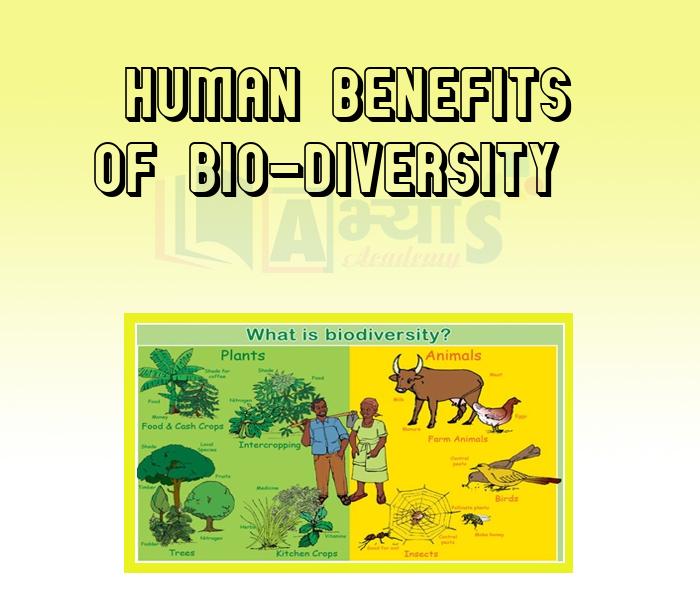Human Benefits Of Bio-Diversity


Human Benefits Of Bio-Diversity
Human Benefits Of Bio-Diversity: Biodiversity helps maintaining the dynamic nature of ecosystem services including air quality, climate (e.g. Carbon Dioxide sequestration), water purification, pollination, and prevention of erosion, thereby creating optimum conditions for human's survival.
1. Agriculture: The variety of genetic traits present in wild varieties is extremely important in improving crop performance. Enhancements in crop species over the last 250 years have added to the resilience of the ecosystem. Human endeavours like Green Revolution, where crop breeding for beneficial traits were attempted, have helped to more than double crop production in the last 50 years. In contrast, unscientific agricultural practices like mono-culture have contributed to several agricultural disasters. Higher biodiversity is important as it limits the spread of infectious diseases because many different species act as buffers to them.
2. Human Health: Biodiversity's importance for human's health can be gauged from the growing concerns over the issue of global health implications of biodiversity loss. This issue is closely linked with the issue of climate change,as many of the anticipated health risks of climate change are associated with changes in biodiversity (eg. changes in populations and distribution of disease vectors, scarcity of fresh water, impacts on agricultural biodiversity and food resources etc). Our dietary health and nutrition security, infectious disease, medical science and medicinal resources, social and psychological health are some of the crucial issues influenced by biodiversity. Besides this, biodiversity is also known to have an important role in reducing disaster risk and in post-disaster relief and recovery efforts,The medicinal value of biodiversity is extremely high and useful, as it provides critical support for drug discovery and the availability of medicinal resources. Today, a significant proportion of drugs are derived directly or indirectly, from biological sources. Marine ecosystems, especially the corals, are particulary important, although inappropriate bio-prospecting can increase biodiversity loss, as well as violating the laws of the communities and states from which the resources are taken.
Inspiration, education, recreation, aesthetic values are part of which services provided to us by the biodiversity ? | |||
| Right Option : B | |||
| View Explanation | |||
Which of the following services provided by the biodiversity regulates the increasing population disease causing microbes ? | |||
| Right Option : C | |||
| View Explanation | |||
What does supporting services include that we get from nature ? | |||
| Right Option : D | |||
| View Explanation | |||
Students / Parents Reviews [10]
My experience with Abhyas academy is very good. I did not think that my every subject coming here will be so strong. The main thing is that the online tests had made me learn here more things.

Hiya Gupta
8thIt has a great methodology. Students here can get analysis to their test quickly.We can learn easily through PPTs and the testing methods are good. We know that where we have to practice

Barkha Arora
10thAbout Abhyas metholodology the teachers are very nice and hardworking toward students.The Centre Head Mrs Anu Sethi is also a brilliant teacher.Abhyas has taught me how to overcome problems and has always taken my doubts and suppoeted me.

Shreya Shrivastava
8thIt was good as the experience because as we had come here we had been improved in a such envirnment created here.Extra is taught which is beneficial for future.

Eshan Arora
8thOne of the best institutes to develope a child interest in studies.Provides SST and English knowledge also unlike other institutes. Teachers are co operative and friendly online tests andPPT develope practical knowledge also.

Aman Kumar Shrivastava
10thAbhyas is a complete education Institute. Here extreme care is taken by teacher with the help of regular exam. Extra classes also conducted by the institute, if the student is weak.

Om Umang
10thBeing a parent, I saw my daughter improvement in her studies by seeing a good result in all day to day compititive exam TMO, NSO, IEO etc and as well as studies. I have got a fruitful result from my daughter.

Prisha Gupta
8thMy experience with Abhyas is very good. I have learnt many things here like vedic maths and reasoning also. Teachers here first take our doubts and then there are assignments to verify our weak points.

Shivam Rana
7thIt was a good experience with Abhyas Academy. I even faced problems in starting but slowly and steadily overcomed. Especially reasoning classes helped me a lot.

Cheshta
10thMy experience was very good with Abhyas academy. I am studying here from 6th class and I am satisfied by its results in my life. I improved a lot here ahead of school syllabus.
